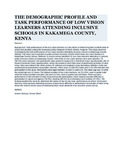| dc.contributor.author | Ashioya, Doreen | |
| dc.contributor.author | Okoth, Teresa | |
| dc.date.accessioned | 2022-01-13T05:00:56Z | |
| dc.date.available | 2022-01-13T05:00:56Z | |
| dc.date.issued | 2020-05 | |
| dc.identifier.uri | http://dx.doi.org/10.46827/ejphs.v3i2.29 | |
| dc.identifier.uri | https://oapub.org/hlt/index.php/EJPHS/article/view/29 | |
| dc.identifier.uri | http://ir-library.mmust.ac.ke:8080/xmlui/handle/123456789/2025 | |
| dc.description.abstract | Background: Task performance of the low vision learners is a key factor in influencing their comfort while at school and possibly cubing the increasing school dropouts in these schools. Purpose: This study aimed at investigating the task performance of low vision learners attending inclusive schools in Kakamega County. Setting: The study was conducted in public primary inclusive schools which hosts low vision learners in Kakamega County, Kenya. Methods: A census survey identified 21 low vision learners attending 11 primary public inclusive schools in Kakamega County. Out of the 21 low vision learners who were selected, 19 (90.5%) were assessed. The participants were guided to respond to a functional vision questionnaire, the LV Prasad Functional Vision Questionnaire, which was meant to elicit their ease of performing activities of daily living. Data was entered into SPSS version 25 software and analyzed using descriptive statistics. Data was summarized and presented using tables. Results: There were 13 (68.4%) males and 6 (31.6%) females who participated in this study. Participants were aged between 10 and 21 years old. The mean age was 14 while the modal age was 13 years. The highest number of low vision learners, six (31.6%), were in grade eight while the lowest number recorded, one each (5.3%), were in grades two and three. There was poor performance in the activities of daily living among the participants, which majorly included difficulty in participation in sports and games (78.9%), reading (89.5%) and orientation and mobility (57.9%). The findings enabled the study to determine the status of day-to-day task -performance at school. Conclusion: Most low vision learners attending inclusive schools have difficulty in performance of activities of daily living hence the need to device ways of addressing their visual demands in an inclusive school set-up. | en_US |
| dc.language.iso | en | en_US |
| dc.publisher | European Journal of Public Health | en_US |
| dc.subject | DEMOGRAPHIC, PROFILE, TASK, PERFORMANCE, LOW, VISION, LEARNERS, ATTENDING, INCLUSIVE, SCHOOLS | en_US |
| dc.title | THE DEMOGRAPHIC PROFILE AND TASK PERFORMANCE OF LOW VISION LEARNERS ATTENDING INCLUSIVE SCHOOLS IN KAKAMEGA COUNTY, KENYA | en_US |
| dc.type | Article | en_US |

